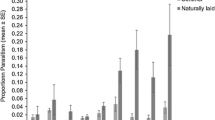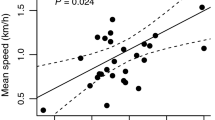Abstract
Emerald ash borer (EAB) Agrilus planipennis Fairmaire (Coleoptera: Buprestidae) is an invasive, wood-boring pest of North American ash trees (Fraxinus spp.). Oobius agrili Zhang and Huang (Hymenoptera: Encyrtidae), a solitary egg parasitoid, was one of the several parasitoids introduced from the pest’s native Northeast Asian range to the USA for EAB classical biocontrol. Since its introduction, this agent has been released over 31 states against EAB, yet determination of the spread and impact of this parasitoid has proved difficult partly because of its small size and cryptic host eggs. The present study examines the dispersal distance and parasitism of O. agrili shortly after release, as well as the impact of host’s food plants (trees), where the host eggs were deployed. Sentinel EAB eggs were deployed on pairs of green ash (Fraxinus pensylvanica) and white fringe (Chionanthus virginicus) trees in circles around the release point up to 45 m away. After 48 or 120 h, the eggs were retrieved and examined for parasitism. There was no significant difference in observed parasitism by distance or tree species. However, significantly more EAB eggs were parasitized in the longer deployment compared to the shorter deployment. These findings suggest that sentinel EAB eggs may be deployed on ash or white fringe trees to effectively monitor the establishment and spread of O. agrili. Future studies using sentinel host eggs in natural ash stands may yield further insights into the spread rate of O. agrili post-release and its effectiveness in suppressing the targeted pest populations over time.



Similar content being viewed by others
References
Abell KJ, Bauer LS, Duan JJ, van Driesche R (2014) Long-term monitoring of the introduced emerald ash borer (Coleoptera: Buprestidae) egg parasitoid, Oobius agrili (Hymenoptera: Encyrtidae), in Michigan, USA and evaluation of a newly developed monitoring technique. Biol Control 79:36–42
Bauer LS, Duan JJ, Gould JR, van Driesche R (2015) Progress in the classical biological control of Agrilus planipennis Fairmaire (Coleoptera: Buprestidae) in North America. Can Entomol 147:300–317
Bosem Baillod A, Tscharntke T, Clough Y, Batáry P (2017) Landscape-scale interactions of spatial and temporal cropland heterogeneity drive biological control of cereal aphids. J Appl Ecol 54:1804–1813
Bukovinszky T, Gols R, Hemerik L, van Lenteren JC, Vet LE (2007) Time allocation of a parasitoid foraging in heterogeneous vegetation: implications for host-parasitoid interactions. J Anim Ecol 76:845–853
Caton BP, Fang H, Manoukis NC, Pallipparambil GR (2022) Quantifying insect dispersal distances from trapping detections data to predict delimiting survey radii. J Appl Entomol 146:203–216
Cipollini D (2015) White fringetree as a novel larval host for emerald ash borer. J Econ Entomol 108:370–375
Cohen AL, Crowder DW (2017) The impacts of spatial and temporal complexity across landscapes on biological control: a review. Curr Opin Insect Sci 20:13–18
Dang Y-Q, Zhang Y-L, Wang X-Y, Xin B, Quinn NF, Duan JJ (2021) Retrospective analysis of factors affecting the distribution of an invasive wood-boring insect using native range data: the importance of host plants. J Pest Sci 94:981–990
Duan JJ, Bauer LS, Ulyshen MD, van Driesche R (2011) Development of methods for the field evaluation of Oobius agrili (Hymenoptera: Encyrtidae) in North America, a newly introduced egg parasitoid of the emerald ash borer (Coleoptera: Buprestidae). Biol Control 56:170–174
Duan JJ, Bauer LS, Hansen JA, Abell KJ, van Driesche R (2012) An improved method for monitoring parasitism and establishment of Oobius agrili (Hymenoptera: Encyrtidae), an egg parasitoid introduced for biological control of the emerald ash borer (Coleoptera: Buprestidae) in North America. Biol Control 60:255–261
Duan JJ, Watt T, Taylor P, Larson K, Lelito JP (2013) Effects of ambient temperature on egg and larval development of the invasive emerald ash borer (Coleoptera: Buprestidae): implications for laboratory rearing. J Econ Entomol 106:2101–2108
Duan JJ, Jennings DE, Williams DC, Larson KM (2014) Patterns of parasitoid host utilization and development across a range of temperatures: implications for biological control of an invasive forest pest. BioControl 59:659–669
Duan JJ, Bauer LS, Abell KJ, Ulyshen MD, van Driesche RG (2015) Population dynamics of an invasive forest insect and associated natural enemies in the aftermath of invasion: implications for biological control. J Appl Ecol 52:1246–1254
Duan JJ, Bauer LS, van Driesche RG, Gould JR (2018) Progress and challenges of protecting North American ash trees from the emerald ash borer using biological control. Forests 9:142
Fagan WF, Lewis MA, Neubert MG, van Den Driessche P (2002) Invasion theory and biological control. Ecol Lett 5:148–157
Fahrner S, Aukema BH (2018) Correlates of spread rates for introduced insects. Glob Ecol Biogeogr 27:734–743
Furlong MJ, Zalucki MP (2017) Climate change and biological control: the consequences of increasing temperatures on host–parasitoid interactions. Curr Opin Insect Sci 20:39–44
Heimpel GE, Asplen MK (2011) A “Goldilocks” hypothesis for dispersal of biological control agents. BioControl 56:441–450
Herms DA, McCullough DG (2014) Emerald ash borer invasion of North America: history, biology, ecology, impacts, and management. Annu Rev Entomol 59:13–30
Hoban J, Duan JJ, Hough-Goldstein J (2016) Effects of temperature and photoperiod on the reproductive biology and diapause of Oobius agrili (Hymenoptera: Encyrtidae), an egg parasitoid of emerald ash borer (Coleoptera: Buprestidae). Environ Entomol 45:726–731
Hoban JN, Duan JJ, Shrewsbury PM (2018) Host utilization and fitness of the larval parasitoid Tetrastichus planipennisi are influenced by emerald ash borer’s food plants: implications for biological control. Biol Control 127:85–93
Jennings DE, Duan JJ, Larson KM, Lelito JP, Shrewsbury PM (2014) Evaluating a new method for monitoring the field establishment and parasitism of Oobius agrili (Hymenoptera: Encyrtidae), an egg parasitoid of emerald ash borer (Coleoptera: Buprestidae). Florida Entomol 97:1263–1265
Jennings DE, Duan JJ, Shrewsbury PM (2018) Comparing methods for monitoring establishment of the emerald ash borer (Agrilus planipennis, Coleoptera: Buprestidae) egg parasitoid Oobius agrili (Hymenoptera: Encyrtidae) in Maryland, USA. Forests 9:659
Jones MI, Gould JR, Warden ML, Fierke MK (2019) Dispersal of emerald ash borer (Coleoptera: Buprestidae) parasitoids along an ash corridor in western New York. Biol Control 128:94–101
Kovacs KF, Haight RG, McCullough DG, Mercader RJ, Siegert NW, Liebhold AM (2010) Cost of potential emerald ash borer damage in US communities, 2009–2019. Ecol Econ 69:569–578
Kristensen NP, Schellhorn NA, Hulthen AD, Howie LJ, De Barro PJ (2013) Wind-borne dispersal of a parasitoid: the process, the model, and its validation. Environ Entomol 42:1137–1148
Liu H, Bauer LS, Miller DL, Zhao T, Gao R, Song L, Luan Q, Jin R, Gao C (2007) Seasonal abundance of Agrilus planipennis (Coleoptera: Buprestidae) and its natural enemies Oobius agrili (Hymenoptera: Encyrtidae) and Tetrastichus planipennisi (Hymenoptera: Eulophidae) in China. Biol Control 42:61–71
Lockwood JL, Cassey P, Blackburn T (2005) The role of propagule pressure in explaining species invasions. Trends Ecol Evol 20:223–228
Lustig A, Worner SP, Pitt JPW, Doscher C, Stouffer DB, Senay SD (2017) A modeling framework for the establishment and spread of invasive species in heterogeneous environments. Ecol Evol 7:8338–8348
MacFarlane DW, Meyer SP (2005) Characteristics and distribution of potential ash tree hosts for emerald ash borer. For Ecol Manag 213:15–24
Macquarrie CJK, Cooke BJ, Saint-Amant R (2019) The predicted effect of the polar vortex of 2019 on winter survival of emerald ash borer and mountain pine beetle. Can J For Res 49:1165–1172
McCullough DG (2019) Challenges, tactics and integrated management of emerald ash borer in North America. Int J Res 93:197–211
Olson DG, Rieske LK (2019) Host range expansion may provide enemy free space for the highly invasive emerald ash borer. Biol Invasions 21:625–635
Parisio MS, Gould JR, Vandenberg JD, Bauer LS, Fierke MK (2014) Investigating individual dispersal capabilities of the eab parasitoids Oobius agrili and Tetrastichus planipennisi. In: Proceedings of the Emerald Ash Borer research and technology development meeting. Wooster, pp 71–72
Parisio MS, Gould JR, Vandenberg JD, Bauer LS, Fierke MK (2017) Evaluation of recovery and monitoring methods for parasitoids released against emerald ash borer. Biol Control 106:45–53
Peterson DL, Böröczky K, Tumlinson J, Cipollini D (2020) Ecological fitting: chemical profiles of plant hosts provide insights on selection cues and preferences for a major buprestid pest. Phytochemistry 176:112397
Petrice TR, Bauer LS, Miller DL, Stanovick JS, Poland TM, Ravlin FW (2021) Monitoring field establishment of the emerald ash borer biocontrol agent Oobius agrili Zhang and Huang (Hymenoptera: Encyrtidae): sampling methods, sample size, and phenology. Biol Control 156:104535
Pureswaran DS, Poland TM (2009) Host selection and feeding preference of Agrilus planipennis (Coleoptera: Buprestidae) on ash (Fraxinus spp.). Environ Entomol 38:757–765
Ragozzino M, Duan JJ, Salom S (2021) Responses of two introduced larval parasitoids to the invasive emerald ash borer (Coleoptera: Buprestidae) infesting a novel host plant, white fringe tree: Implication for biological control. Biol Control 160:104672
Ramsfield TD, Bentz BJ, Faccoli M, Jactel H, Brockerhoff EG (2016) Forest health in a changing world: effects of globalization and climate change on forest insect and pathogen impacts. Forestry 89:245–252
Tobin PC, Turcotte RM, Blackburn LM, Juracko JA, Simpson BT (2017) The big chill: quantifying the effect of the 2014 North American cold wave on hemlock woolly adelgid populations in the central Appalachian Mountains. Popul Ecol 59:251–258
Weisser WW, Volkl W, Hassell MP (1997) The importance of adverse weather conditions for behaviour and population ecology of an aphid parasitoid. J Anim Ecol 66:386–400
Williams HE, Brockerhoff EG, Liebhold AM, Ward DF (2021) Probing the role of propagule pressure, stochasticity, and Allee effects on invasion success using experimental introductions of a biological control agent. Ecol Entomol 46:383–393
Wittmann MJ, Metzler D, Gabriel W, Jeschke JM (2014) Decomposing propagule pressure: the effects of propagule size and propagule frequency on invasion success. Oikos 123:441–450
Acknowledgements
ARS agreement # 59-8010-0-003 funded by the Farm Bill Program.
Author information
Authors and Affiliations
Contributions
Project conception and coordination: Jian Duan (USDA-ARS) and Nicole Quinn (USDA-ARS and University of Massachusetts). Data collection: Nicole Quinn, Becca Robertson, Jon Schmude, Adam Scherr, Destiny Brumbaugh, Jess Faucher, Joseph Kovach, Sherri Jackson, Kelsey Miles. Original manuscript preparation: Nicole Quinn. Manuscript review: Jian Duan and Joe Elkinton (University of Massachusetts).
Corresponding author
Ethics declarations
Conflict of interest
The authors have no relevant financial or non-financial competing interests to disclose.
Ethical approval
The authors have no relevant financial or non-financial competing interests to disclose. This work was done in compliance with all BioControl ethical standards.
Additional information
Handling Editor: Stefano Colazza.
Rights and permissions
About this article
Cite this article
Quinn, N.F., Duan, J.J. & Elkinton, J. Monitoring the impact of introduced emerald ash borer parasitoids: factors affecting Oobius agrili dispersal and parasitization of sentinel host eggs. BioControl 67, 387–394 (2022). https://doi.org/10.1007/s10526-022-10149-3
Received:
Accepted:
Published:
Issue Date:
DOI: https://doi.org/10.1007/s10526-022-10149-3




